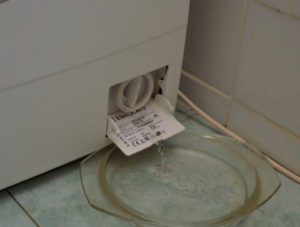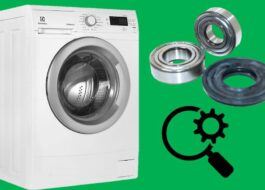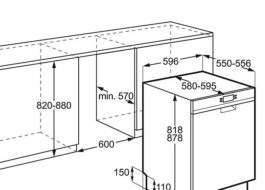Electrolux washing machine does not drain water
 An automatic washing machine has long become a must-have appliance in every modern apartment. One of the most popular examples is the Electrolux washing machine. And it's deserved. After all, it is distinguished by its reliability, structural strength and high quality washing.
An automatic washing machine has long become a must-have appliance in every modern apartment. One of the most popular examples is the Electrolux washing machine. And it's deserved. After all, it is distinguished by its reliability, structural strength and high quality washing.
With all the significant advantages, there is also a disadvantage. As a rule, if the light on the panel indicates an error, the machine does not drain the water. Let's try to figure out what the source of the problem is and what needs to be done in this situation.
Why is draining impossible?
The first step is to find out why the drain is not working. There are several options.
- First, take a closer look at the hose; it drains water from the washing machine into the drain. Something from the washing machine may have gotten into it and the object is blocking the water from passing through. And if it is connected using a siphon, then the problem may be in the latter.
- Small objects, such as coins or buttons, sometimes end up in the filter during washing. Due to clogging, it becomes impossible to drain the water.
- There is a drain pipe inside the machine between the tank and the pump. Perhaps something got into it and the water is not passing through.
- The cause of the problem may be the pump that pumps water. In this case, you will also hear a specific hum. This part has a limited service life, up to 5 years.
Both the electric motor and the shaft with the plastic impeller can break down. Threads, laces, and hair usually get wrapped around it and cause an accident.
If the washing machine has been working in your home for quite some time, then you need to pay attention to the electronic component. Failure is possible due to natural wear and tear of the module or a sudden voltage surge.
How long the drain hose is may also matter. Traditionally the length is one and a half meters. And the pump power is designed specifically for these dimensions. And, if not so long ago you decided to move a new washing machine and had to extend the hose, then perhaps this is the reason for the problem. The washing machine not only does not drain the water, but also does not wring out the clothes? Then you need to make sure which program is set. It's possible that this feature is simply disabled.
As a rule, modern equipment is equipped with an electronic display, which can help in determining the cause of problems (the machine will display an error code). The instructions also contain combinations of light bulbs that light up to indicate a problem in machines without a display.
There are problems that cannot be eliminated on your own. For example, when a washing machine fills with water and immediately drains. The damage may be in the electronic module, the water inlet valve is broken or the water level switch has failed.
Let's remove the water first
So, having determined why the machine refuses to drain the water, you need to do it manually. There are several tricks you can use.
- Through a filter. Pre-prepare a container where you will drain the water from the tank. Please note that there will be quite a lot of liquid and you will need several of them. Unscrew the filter. The water should flow out quickly. When the flow decreases, tilt the machine forward and try to drain everything completely.
- Have you unscrewed the filter but no water comes out? This means the pipe is clogged. Sometimes you just need to move it slightly and the liquid will flow out. Otherwise, it needs to be cleaned and then it can be drained.
- If your actions do not lead to results and the water does not drain from the tank, then you can lower the hose inside and drain it into the container located below.
In any case, your task is to try to ensure that there is no liquid left in the washing machine.
Procedure for finding and eliminating defects
Having dealt with the first problem, we will try to troubleshoot. The very first thing you need to do is disconnect the equipment from the electricity. If you drained water through a filter, you have already checked whether it was clogged and cleaned the pipe. If you got rid of water using a hose, unscrew the filter. A small amount of water will drain, prepare a container or rag. See if anything has fallen into this compartment. You have done all the steps described above, but the machine still does not drain the water.
You need to check the drain pipe. You will have to try and disassemble the machine a little by unscrewing the fastening screws of the drain assembly. Then remove the pipe and feel it with your fingers. If there is a blockage somewhere, you will be able to feel it. After cleaning, install all the parts in place and tighten the screws.

We have already written that threads, hair or laces wound around the impeller can become a source of breakdown. How can I check this? It is located immediately behind the filter. Try to rotate the impeller. If this is not possible, it is jammed. We'll have to free her from interfering objects. If after these steps the impeller does not start spinning, then the problem is inside the pump.
You can check whether it is damaged yourself. What do we have to do? Unscrew the filter. Program the washing machine to spin. Next, look into the drain hole. You can use a flashlight. The impeller in your case will be motionless.
But there are situations when the impeller rotates, but the machine is still faulty. This usually happens in older devices. It works on the spin cycle, but not on the drain. This situation occurs due to natural wear and tear of components. Due to improper operation of the magnet, the pump jams and the machine does not spin out.
Why is this happening? The magnets are located in a plastic cup inside the pump. Voltage enters its winding and ensures the movement of the rod. The cuff protects against water and dirt. If it is damaged, the operation of the part is disrupted.
After 7 years, the magnets themselves may become weaker, causing the pump to weaken and malfunction.
The part will have to be replaced. You can easily identify such a problem by the characteristic noise in the “Spin” mode. In this case, the program does not perform the specified function. The drain pump may need to be replaced.
The drain pump is at fault
 Drawing conclusions from the above, if your washing machine begins to hum a lot, but does not spin out the laundry and water leaves, then the problem is that the pump is faulty. The problem is quite serious, but the repair can be done by yourself.
Drawing conclusions from the above, if your washing machine begins to hum a lot, but does not spin out the laundry and water leaves, then the problem is that the pump is faulty. The problem is quite serious, but the repair can be done by yourself.
The replacement instructions begin with removing the drain assembly. Then unfasten the drain pump. Disconnect the old wires. Swap the old and new parts. Connect the wires. Only after this we connect the washing machine to the power supply. And we do a test wash. If this time the drainage of water does not go well, then you cannot do without contacting the service department.
Use the machine correctly
How to avoid all these troubles and increase the service life of equipment? There are a few simple rules that must be followed.
- Pay attention to the parameters specified in the passport for your washing machine.Namely, the maximum weight of laundry recommended for one wash. In the case when you overload the device, it has to work at its limit. And this, of course, significantly increases the risk of an accident.
- Always check your clothes before putting them in the washing machine. Firstly, the pockets. There may be coins, headphones, candy wrappers, pieces of paper, pins or even paper clips left in them. Secondly, any small details of clothing. For example, buttons, beads, clasps. You need to make sure that they are securely fastened. All these foreign objects can become a source of damage to your equipment if they accidentally get inside the structure.
- Use it voltage stabilizer when connecting the machine to the network. This will protect your equipment from strong power surges. They can significantly degrade the operation of the electronic module or completely destroy it.
- Clean the filter regularly. It is recommended to do this procedure every six months. But, if you check its condition at least once a year, this will help you avoid future troubles. Most often, this is why the washing machine stops draining water.
Also, don’t be lazy, study the washing programs included in the model of your equipment. Before starting work, check whether the parameters are set correctly. Organize preventative washing annually to protect machine components from scale and dirt.
Add any descaling agent and washing powder. Set the program with the highest water heating temperature on the electronic display. Without adding laundry, run a full wash cycle. By following these simple tips, you will increase the life of your washing machine and avoid troubles from its damage.
Interesting:
1 reader comment





















Thanks for the simple advice.